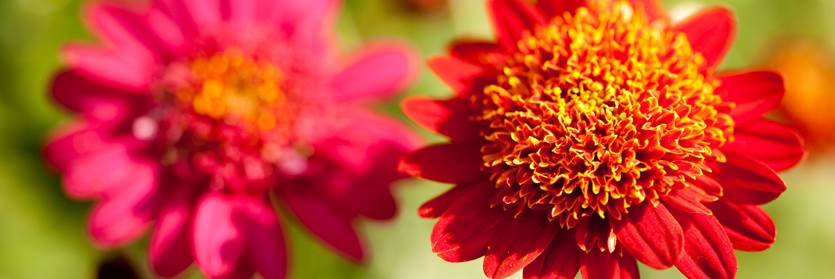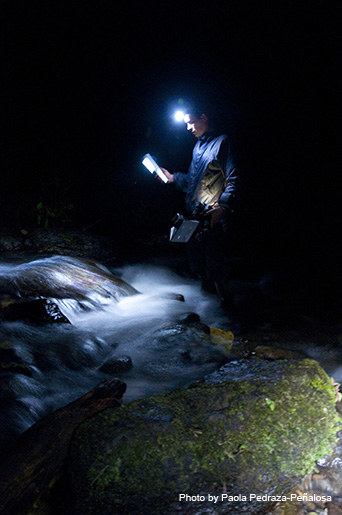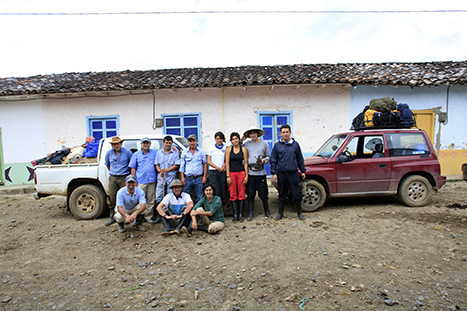Morning Eye Candy: Millinery
Posted in Photography on April 6 2011, by Ann Rafalko
If Isabella Blow were an orchid.
Photo by Ivo M. Vermeulen

Inside The New York Botanical Garden
Posted in Photography on April 6 2011, by Ann Rafalko
If Isabella Blow were an orchid.
Photo by Ivo M. Vermeulen
Posted in Photography on March 17 2011, by Plant Talk
Is it just us, or does this orchid bear a striking resemblence to the lead singer of an iconic British rock band?
(photo by Mark Pfeffer)
Posted in Photography on March 11 2011, by Plant Talk
The Orchid Show: On Broadway has been receiving rave reviews! Have you come to see the most spectacular show in New York City yet?
Posted in From the Field, Paola Pedraza-Peñalosa, Science on March 10 2011, by Plant Talk
Ed. Note: NYBG Scientist and Assistant Curator, Institute of Systematic Botany, Paola, Pedraza-Peñalosa recently returned from an expedition to the Colombian Andes where she was without electricity and the Internet. Upon returning to New York, she filed these briefs about her time in the field. Follow her journey on Plant Talk.
February 4, 2011; The findings, Las Orquídeas National Park; Antioquia, Colombia
Each day had its findings. Each day came with at least one amazing plant that brought all work to a stop. That plant could be one we thought was special because of its rarity (restricted geographic distribution), or one that locals use in some interesting way; sometimes a plant could be deemed special just because it is simply too beautiful. We have selected some of our favorite plants to share them with you.
Posted in From the Field, Paola Pedraza-Peñalosa, Science on March 9 2011, by Plant Talk
Ed. Note: NYBG Scientist and Assistant Curator, Institute of Systematic Botany, Paola, Pedraza-Peñalosa recently returned from an expedition to the Colombian Andes where she was without electricity and the Internet. Upon returning to New York, she filed these briefs about her time in the field. Follow her journey on Plant Talk.
January 31, 2011; A typical day botanizing in Las Orquídeas National Park; Antioquia, Colombia
So what exactly does a botanist do in the field? In the field we look for plants that are in reproductive state, those bearing flowers or/and fruits. Reproductive structures are necessary to differentiate between closely looking species. For each species, we collect flowers, fruits, and leaves; these samples are processed and later dried for future study. The dried and mounted plant samples are called herbarium specimens and they are known to last for hundreds of years.
Posted in Photography on March 9 2011, by Plant Talk
In honor of opening week at The Orchid Show: On Broadway, we are using “Morning Eye Candy” as an opportunity to introduce you to the cast of characters that play both the starring roles and the bit parts in the Garden‘s ode to all things orchid and Broadway.
(photo by Ivo M. Vermeulen)
Previously Featured Cast Members of The Orchid Show: On Broadway:
Posted in From the Field, Paola Pedraza-Peñalosa, Science on March 8 2011, by Plant Talk
Ed. Note: NYBG Scientist and Assistant Curator, Institute of Systematic Botany, Paola, Pedraza-Peñalosa recently returned from an expedition to the Colombian Andes where she was without electricity and the Internet. Upon returning to New York, she filed these briefs about her time in the field. Follow her journey on Plant Talk.
January 25, 2011; Arrival to Las Orquídeas National Park; Antioquia, Colombia
Las Orquídeas National Park is tucked into the westernmost mountain chain of Colombia, a part of the great Andean Cordillera. In the park the terrain is steep and rough and is crossed by many rivers and streams that originate in the upper part of the mountains. The constant presence of water makes these humid forests a source of abudant epiphytic plants. Epiphytes, like many bromeliads and orchids, are plants that grow on other plants without killing them. Epiphytes root in the humid mixture of mosses and decaying matter that cover the branches of the trees; they are a forest on top of the forest.
Posted in Photography on March 8 2011, by Plant Talk
In honor of opening week at The Orchid Show: On Broadway, we are using “Morning Eye Candy” as an opportunity to introduce you to the cast of characters that play both the starring roles and the bit parts in the Garden‘s ode to all things orchid and Broadway.
(photo by Ivo M. Vermeulen)
Previously Featured Cast Members of The Orchid Show: On Broadway:
Posted in From the Field, Paola Pedraza-Peñalosa, Science on March 7 2011, by Plant Talk
Ed. Note: NYBG Scientist and Assistant Curator, Institute of Systematic Botany, Paola Pedraza-Peñalosa recently returned from an expedition to the Colombian Andes where she was without electricity and the Internet. Upon returning to New York, she filed these briefs about her time in the field. Follow her journey on Plant Talk.

The Andes mountain chain, which crosses South America from north to south, is the longest in the world. The Andean forests of the northern range (Tropical Andes hotspot) are home to a level of plant diversity that is without match anywhere else in the world; they are also subject to high rates of deforestation, thus these forests are considered a top priority for conservation. Unfortunately, Andean forests remain insufficiently studied and protected. This lack of baseline information is often times the first impediment to effective conservation: It is impossible to efficiently protect what we do not know or understand.
To help fill these gaps, The New York Botanical Garden and the Universidad Nacional de Colombia have formed a partnership in order to inventory all the species of ferns, gymnosperms, and flowering plants of Las Orquídeas National Park, a forest reserve strategically located in the confluence of the Andean and Chocó biogeographic regions of Colombia.

January 24 – February 4: Plant inventory at Las Orquídeas National Park; Antioquia, Colombia
After 14 days collecting plants in the field, we returned to Bogotá, Colombia’s capital with nearly 700 plant collections, and more than 10,000 photographs. Behind us we left Las Orquídeas National Park‘s 32 thousand hectares of rare and endangered tropical and montane forests, which make it part of one of the most biologically rich ecosystems of the world: the Andean and Chocó forests. We left behind more than 2,000 species of vascular plants, some of them still unknown to the science and probably not found anywhere else.
The following is an account of how we got there, what we did, and why what we found is important.
Posted in Photography on March 7 2011, by Plant Talk
In honor of opening week at The Orchid Show: On Broadway, we are using “Morning Eye Candy” as an opportunity to introduce you to the cast of characters that play both the starring roles and the bit parts in the Garden‘s ode to all things orchid and Broadway.
(photo by Ivo M. Vermeulen)
Previously Featured Cast Members of The Orchid Show: On Broadway: